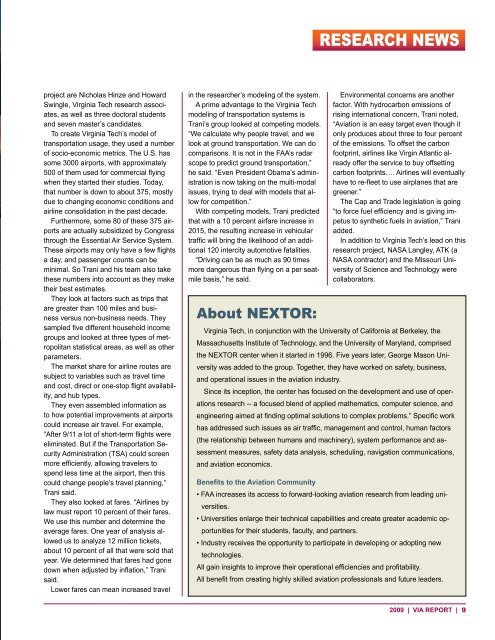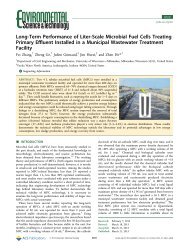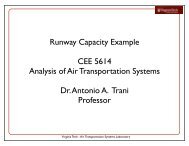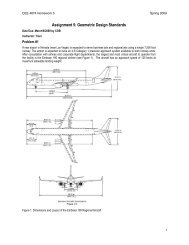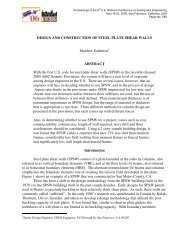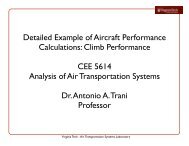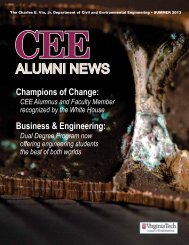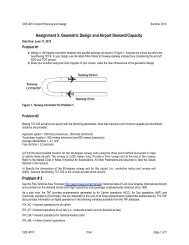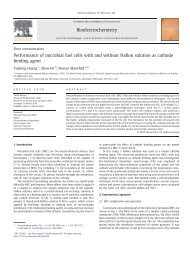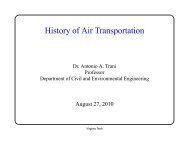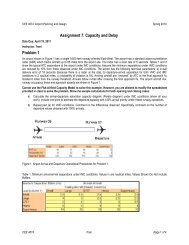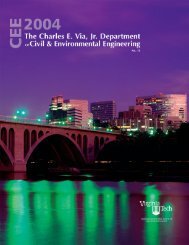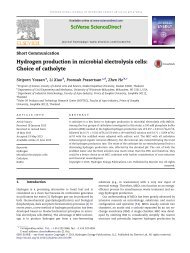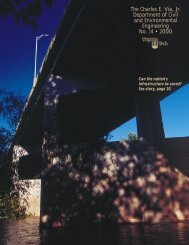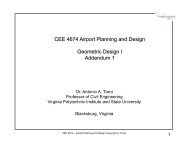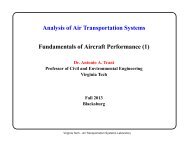Annual Report Year 2009 - Civil and Environmental Engineering
Annual Report Year 2009 - Civil and Environmental Engineering
Annual Report Year 2009 - Civil and Environmental Engineering
- No tags were found...
You also want an ePaper? Increase the reach of your titles
YUMPU automatically turns print PDFs into web optimized ePapers that Google loves.
RESEARCH NEWS<br />
project are Nicholas Hinze <strong>and</strong> Howard<br />
Swingle, Virginia Tech research associates,<br />
as well as three doctoral students<br />
<strong>and</strong> seven master’s c<strong>and</strong>idates.<br />
To create Virginia Tech’s model of<br />
transportation usage, they used a number<br />
of socio-economic metrics. The U.S. has<br />
some 3000 airports, with approximately<br />
500 of them used for commercial flying<br />
when they started their studies. Today,<br />
that number is down to about 375, mostly<br />
due to changing economic conditions <strong>and</strong><br />
airline consolidation in the past decade.<br />
Furthermore, some 80 of these 375 airports<br />
are actually subsidized by Congress<br />
through the Essential Air Service System.<br />
These airports may only have a few flights<br />
a day, <strong>and</strong> passenger counts can be<br />
minimal. So Trani <strong>and</strong> his team also take<br />
these numbers into account as they make<br />
their best estimates.<br />
They look at factors such as trips that<br />
are greater than 100 miles <strong>and</strong> business<br />
versus non-business needs. They<br />
sampled five different household income<br />
groups <strong>and</strong> looked at three types of metropolitan<br />
statistical areas, as well as other<br />
parameters.<br />
The market share for airline routes are<br />
subject to variables such as travel time<br />
<strong>and</strong> cost, direct or one-stop flight availability,<br />
<strong>and</strong> hub types.<br />
They even assembled information as<br />
to how potential improvements at airports<br />
could increase air travel. For example,<br />
“After 9/11 a lot of short-term flights were<br />
eliminated. But if the Transportation Security<br />
Administration (TSA) could screen<br />
more efficiently, allowing travelers to<br />
spend less time at the airport, then this<br />
could change people’s travel planning,”<br />
Trani said.<br />
They also looked at fares. “Airlines by<br />
law must report 10 percent of their fares.<br />
We use this number <strong>and</strong> determine the<br />
average fares. One year of analysis allowed<br />
us to analyze 12 million tickets,<br />
about 10 percent of all that were sold that<br />
year. We determined that fares had gone<br />
down when adjusted by inflation,” Trani<br />
said.<br />
Lower fares can mean increased travel<br />
in the researcher’s modeling of the system.<br />
A prime advantage to the Virginia Tech<br />
modeling of transportation systems is<br />
Trani’s group looked at competing models.<br />
“We calculate why people travel, <strong>and</strong> we<br />
look at ground transportation. We can do<br />
comparisons. It is not in the FAA’s radar<br />
scope to predict ground transportation,”<br />
he said. “Even President Obama’s administration<br />
is now taking on the multi-modal<br />
issues, trying to deal with models that allow<br />
for competition.”<br />
With competing models, Trani predicted<br />
that with a 10 percent airfare increase in<br />
2015, the resulting increase in vehicular<br />
traffic will bring the likelihood of an additional<br />
120 intercity automotive fatalities.<br />
“Driving can be as much as 90 times<br />
more dangerous than flying on a per seatmile<br />
basis,” he said.<br />
About NEXTOR:<br />
<strong>Environmental</strong> concerns are another<br />
factor. With hydrocarbon emissions of<br />
rising international concern, Trani noted,<br />
“Aviation is an easy target even though it<br />
only produces about three to four percent<br />
of the emissions. To offset the carbon<br />
footprint, airlines like Virgin Atlantic already<br />
offer the service to buy offsetting<br />
carbon footprints…. Airlines will eventually<br />
have to re-fleet to use airplanes that are<br />
greener.”<br />
The Cap <strong>and</strong> Trade legislation is going<br />
“to force fuel efficiency <strong>and</strong> is giving impetus<br />
to synthetic fuels in aviation,” Trani<br />
added.<br />
In addition to Virginia Tech’s lead on this<br />
research project, NASA Langley, ATK (a<br />
NASA contractor) <strong>and</strong> the Missouri University<br />
of Science <strong>and</strong> Technology were<br />
collaborators.<br />
Virginia Tech, in conjunction with the University of California at Berkeley, the<br />
Massachusetts Institute of Technology, <strong>and</strong> the University of Maryl<strong>and</strong>, comprised<br />
the NEXTOR center when it started in 1996. Five years later, George Mason University<br />
was added to the group. Together, they have worked on safety, business,<br />
<strong>and</strong> operational issues in the aviation industry.<br />
Since its inception, the center has focused on the development <strong>and</strong> use of operations<br />
research -- a focused blend of applied mathematics, computer science, <strong>and</strong><br />
engineering aimed at finding optimal solutions to complex problems.” Specific work<br />
has addressed such issues as air traffic, management <strong>and</strong> control, human factors<br />
(the relationship between humans <strong>and</strong> machinery), system performance <strong>and</strong> assessment<br />
measures, safety data analysis, scheduling, navigation communications,<br />
<strong>and</strong> aviation economics.<br />
Benefits to the Aviation Community<br />
• FAA increases its access to forward-looking aviation research from leading universities.<br />
• Universities enlarge their technical capabilities <strong>and</strong> create greater academic opportunities<br />
for their students, faculty, <strong>and</strong> partners.<br />
• Industry receives the opportunity to participate in developing or adopting new<br />
technologies.<br />
All gain insights to improve their operational efficiencies <strong>and</strong> profitability.<br />
All benefit from creating highly skilled aviation professionals <strong>and</strong> future leaders.<br />
<strong>2009</strong> | VIA REPORT | 9


